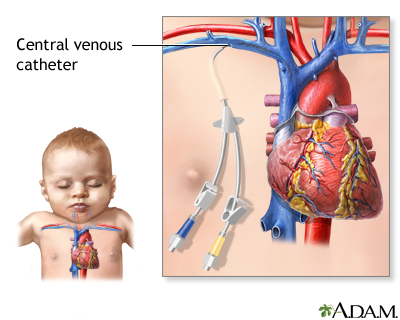Central line infections - hospitals
Central line-associated bloodstream infection; CLABSI; Peripherally inserted central catheter - infection; PICC - infection; Central venous catheter - infection; CVC - infection; Central venous device - infection; Infection control - central line infection; Nosocomial infection - central line infection; Hospital acquired infection - central line infection; Patient safety - central line infection
You have a central line. This is a long tube (catheter) that goes into a vein in your chest, arm, or groin and ends in your heart or in a large vein usually near your heart.
Images

I Would Like to Learn About:
What is a Central Line?
Your central line carries nutrients, fluids, and medicine into your body. It can also be used to take blood when you need to have blood tests.
Central line infections are very serious. They can make you sick and increase how long you are in the hospital. Your central line needs special care to prevent infection.
Preventing Central Line Infections in the Hospital
You may have a central line if you:
- Need antibiotics or other medicines for an extended period of time
- Require nutrition or hydration because your bowels are not working correctly and do not absorb enough nutrients and calories
- Need to receive a large amount of blood or fluid quickly
- Need to have blood samples taken more than once a day
- Need kidney dialysis
Anyone who has a central line can get an infection. Your risk is higher if you:
- Are in the intensive care unit (ICU)
- Have a weakened immune system or serious illness
- Are having a bone marrow transplant or chemotherapy
- Have the line for a long time
- Have a central line in your groin
What the Hospital Should Do
The hospital staff will use aseptic technique when a central line is put in your chest or arm. Aseptic technique means keeping everything as sterile (germ-free) as possible. They will:
- Wash their hands
- Put on a mask, gown, cap, and sterile gloves
- Clean the site where the central line will be placed
- Use a sterile cover for your body
- Make sure everything they touch during the procedure is sterile
- Cover the catheter with gauze or clear plastic tape once it is in place
Hospital staff should check your central line every day to make sure it is in the right place and to look for signs of infection. The gauze or tape over the site should be changed if it is dirty.
How you can Help During Your Hospital Stay
Make sure not to touch your central line unless you have washed your hands.
Tell your nurse if your central line:
- Gets dirty
- Is coming out of your vein
- Is leaking, or the catheter is cut or cracked
You can take a shower when your health care provider says it is OK to do so. Your nurse will help you cover your central line when you shower to keep it clean and dry.
Signs of Infection to Watch for
If you notice any of these signs of infection, tell your provider or nurse right away:
- Redness at the site, or red streaks around the site
- Swelling or warmth at the site
- Yellow or green drainage
- Pain or discomfort
- Fever
References
Agency for Healthcare Research and Quality website. Appendix 2. Central Line-Associated Bloodstream Infections Fact Sheet. ahrq.gov/hai/clabsi-tools/appendix-2.html. Updated March 2018. Accessed February 13, 2024.
Beekman SE, Henderson DK. Infections caused by percutaneous intravascular devices. In: Bennett JE, Dolin R, Blaser MJ, eds. Mandell, Douglas, and Bennett's Principles and Practice of Infectious Diseases. 9th ed. Philadelphia, PA: Elsevier; 2020:chap 300.
Bell T, O'Grady NP. Prevention of central line-associated bloodstream infections. Infect Dis Clin North Am. 2017;31(3):551-559. PMID: 28687213 pubmed.ncbi.nlm.nih.gov/28687213/.
Calfee DP. Prevention and control of health care-associated infections. In: Goldman L, Cooney KA, eds. Goldman-Cecil Medicine. 27th ed. Philadelphia, PA: Elsevier; 2024:chap 261.
BACK TO TOPReview Date: 2/3/2024
Reviewed By: Frank D. Brodkey, MD, FCCM, Associate Professor, Section of Pulmonary and Critical Care Medicine, University of Wisconsin School of Medicine and Public Health, Madison, WI. Also reviewed by David C. Dugdale, MD, Medical Director, Brenda Conaway, Editorial Director, and the A.D.A.M. Editorial team.

Health Content Provider
06/01/2025
|
A.D.A.M., Inc. is accredited by URAC, for Health Content Provider (www.urac.org). URAC's accreditation program is an independent audit to verify that A.D.A.M. follows rigorous standards of quality and accountability. A.D.A.M. is among the first to achieve this important distinction for online health information and services. Learn more about A.D.A.M.'s editorial policy, editorial process and privacy policy. A.D.A.M. is also a founding member of Hi-Ethics. This site complied with the HONcode standard for trustworthy health information from 1995 to 2022, after which HON (Health On the Net, a not-for-profit organization that promoted transparent and reliable health information online) was discontinued. |
The information provided herein should not be used during any medical emergency or for the diagnosis or treatment of any medical condition. A licensed medical professional should be consulted for diagnosis and treatment of any and all medical conditions. Links to other sites are provided for information only -- they do not constitute endorsements of those other sites. © 1997- 2025 A.D.A.M., a business unit of Ebix, Inc. Any duplication or distribution of the information contained herein is strictly prohibited.
